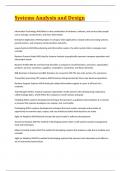Exam (elaborations)
Systems Analysis and Design ) (Solved Questions 100% VERIFIED QUESTIONS AND ANSWERS)
- Module
- Systems Analysis and Design
- Institution
- Systems Analysis And Design
Information Technology ANS:Refers to the combination of hardware, software, and services that people use to manage, communicate, and share information. Enterprise Applications ANS:Examples of company-wide applications; include order processing systems, payroll systems, and company communications n...
[Show more]



